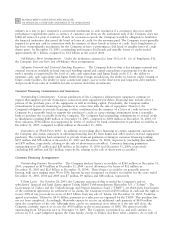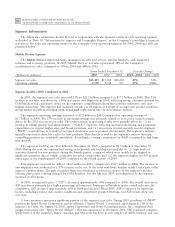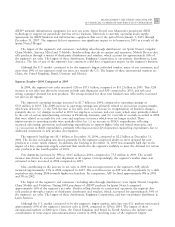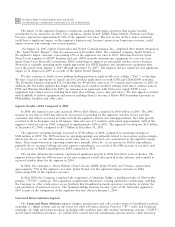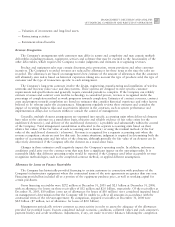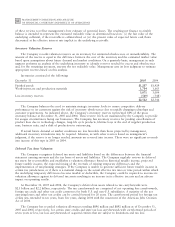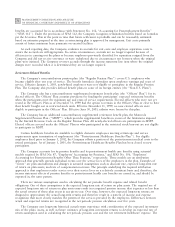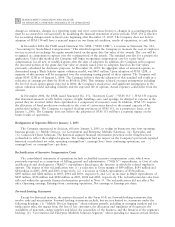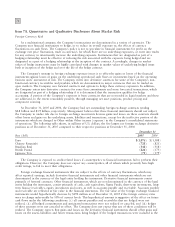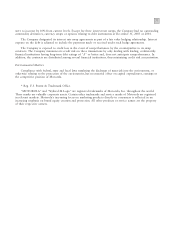Motorola 2005 Annual Report Download - page 75
Download and view the complete annual report
Please find page 75 of the 2005 Motorola annual report below. You can navigate through the pages in the report by either clicking on the pages listed below, or by using the keyword search tool below to find specific information within the annual report.
68 MANAGEMENT'S DISCUSSION AND ANALYSIS
OF FINANCIAL CONDITION AND RESULTS OF OPERATIONS
of these reviews to reflect management's best estimate of potential losses. The resulting net finance receivable
balance is intended to represent the estimated realizable value as determined based on: (i) the fair value of the
underlying collateral, if the receivable is collateralized, or (ii) the present value of expected future cash flows
discounted at the effective interest rate implicit in the underlying receivable.
Inventory Valuation Reserves
The Company records valuation reserves on its inventory for estimated obsolescence or unmarketability. The
amount of the reserve is equal to the difference between the cost of the inventory and the estimated market value
based upon assumptions about future demand and market conditions. On a quarterly basis, management in each
segment performs an analysis of the underlying inventory to identify reserves needed for excess and obsolescence
and, for the remaining inventory, assesses the net realizable value. Management uses its best judgment to estimate
appropriate reserves based on this analysis.
Inventories consisted of the following:
December 31
2005
2004
Finished goods $1,287 $1,429
Work-in-process and production materials 1,784 1,665
3,071 3,094
Less inventory reserves (549) (548)
$2,522 $2,546
The Company balances the need to maintain strategic inventory levels to ensure competitive delivery
performance to its customers against the risk of inventory obsolescence due to rapidly changing technology and
customer requirements. As indicated above, the Company's inventory reserves represented 18% of the gross
inventory balance at December 31, 2005 and 2004. These reserve levels are maintained by the Company to provide
for unique circumstances facing our businesses. The Company has inventory reserves for pending cancellations of
product lines due to technology changes, long-life cycle products, lifetime buys at the end of supplier production
runs, business exits, and a shift of production to outsourcing.
If actual future demand or market conditions are less favorable than those projected by management,
additional inventory writedowns may be required. Likewise, as with other reserves based on management's
judgment, if the reserve is no longer needed, amounts are reversed into income. There were no significant reversals
into income of this type in 2005 or 2004.
Deferred Tax Asset Valuation
The Company recognizes deferred tax assets and liabilities based on the differences between the financial
statement carrying amounts and the tax bases of assets and liabilities. The Company regularly reviews its deferred
tax assets for recoverability and establishes a valuation allowance based on historical taxable income, projected
future taxable income, the expected timing of the reversals of existing temporary differences and the
implementation of tax-planning strategies. If the Company is unable to generate sufficient future taxable income in
certain tax jurisdictions, or if there is a material change in the actual effective tax rates or time period within which
the underlying temporary differences become taxable or deductible, the Company could be required to increase its
valuation allowance against its deferred tax assets resulting in an increase in its effective tax rate and an adverse
impact on operating results.
At December 31, 2005 and 2004, the Company's deferred tax assets related to tax carryforwards were
$2.1 billion and $2.2 billion, respectively. The tax carryforwards are comprised of net operating loss carryforwards,
foreign tax credit and other tax credit carryovers for both U.S. and non-U.S. subsidiaries. A majority of the net
operating losses and other tax credits can be carried forward for 20 years. The carryforward period for foreign tax
credits was extended to ten years, from five years, during 2004 with the enactment of the American Jobs Creation
Act of 2004.
The Company has recorded valuation allowances totaling $896 million and $892 million as of December 31,
2005 and 2004, respectively, for certain state credits and state tax loss carryforwards with carryforward periods of
seven years or less, tax loss carryforwards of acquired entities that are subject to limitations and tax loss


